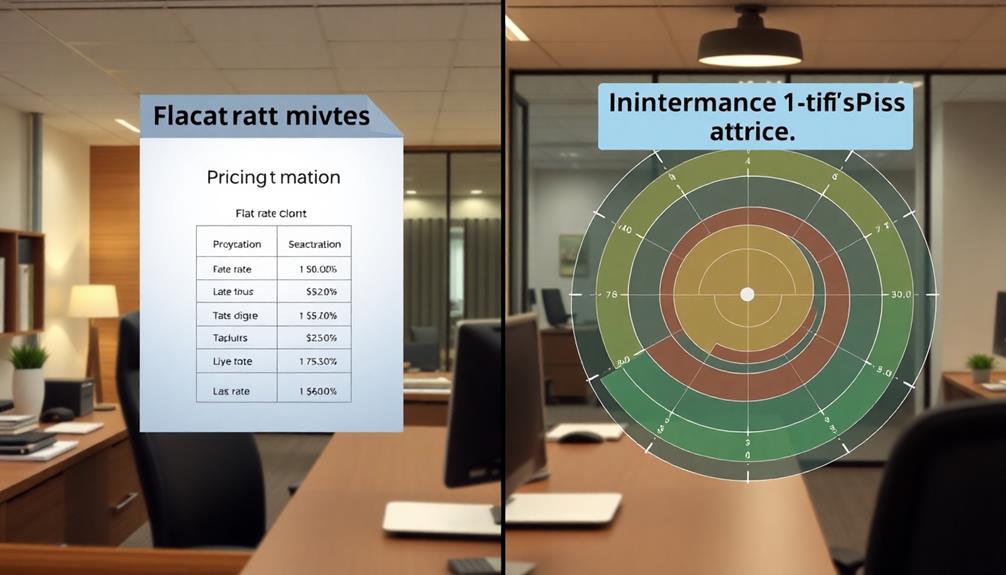When choosing between flat-rate and interchange-plus pricing, weigh both the pros and cons. Flat-rate pricing offers simplicity and predictable costs, making it great for small businesses with lower transaction volumes. However, if your volume increases, those costs can add up quickly. On the other hand, interchange-plus pricing gives you transparency in fee structures and potential savings for higher transaction volumes, though it can be complex and requires strong financial management skills. Understanding these differences can help you decide which model best suits your business needs and aims for cost efficiency. You'll uncover more insights shortly.
Key Takeaways
- Flat-rate pricing offers simplicity and predictability, making it ideal for small businesses with lower transaction volumes.
- Interchange-plus pricing provides transparency and potential cost savings, especially beneficial for businesses with high transaction volumes.
- Flat-rate fees can accumulate quickly, leading to higher costs for businesses processing many transactions.
- Interchange-plus requires careful scrutiny of variable fees and potential hidden costs, which may overwhelm smaller businesses.
- Choosing the right model depends on transaction values, chargeback frequency, and specific business growth needs.
Overview of Credit Card Processing
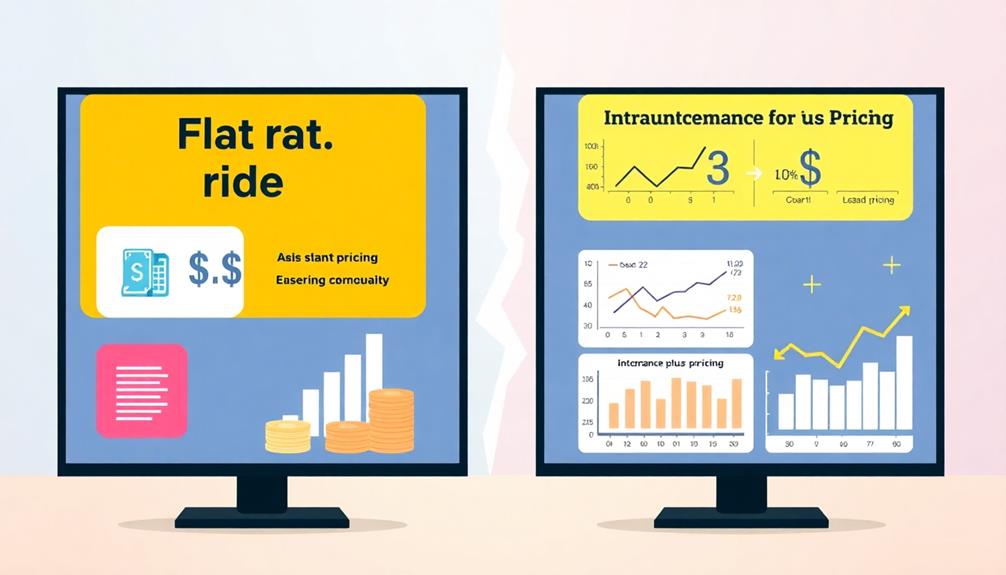
Credit card processing is a complex system involving multiple parties working together to facilitate transactions. When a customer presents their credit card, payment processors communicate with the issuing bank to obtain approval for the transaction. Once approved, the transaction is batched and settled at the end of the day, allowing you to receive payments efficiently.
Understanding credit card processing fees is essential for any business, as fees can greatly impact cash flow management and overall profitability. These fees can vary based on location and transaction types, so it's important to evaluate the benefits of merchant account credit processing when assessing your options.
Two common pricing structures are the Interchange Plus model and the flat rate pricing model. With the Interchange Plus model, you pay interchange fees plus a fixed markup from the processor, which can be more transparent but may lead to fluctuating costs. On the other hand, the flat rate pricing model simplifies your fee structure by charging a consistent percentage on all credit card transactions, making it easier to predict costs.
Choosing the right processing fees and pricing structure depends on your business's financial needs and transaction volumes. Evaluating these options will help you make informed decisions to optimize your payment processing.
Understanding Flat-Rate Pricing

When you opt for flat-rate pricing, you benefit from a simplified fee structure that charges a fixed percentage plus a small transaction fee.
This model is particularly advantageous for businesses with consistent sales volume, as it can lead to easier financial management and predictability in budgeting.
However, it's important to evaluate how this model might impact your overall expenses, especially if your transaction volume is high, as credit card debt in the U.S. exceeded $930 billion in 2020.
Simplified Fee Structure
Flat-rate pricing simplifies your payment processing by offering a single, fixed fee—usually around 2.9% plus $0.30 per transaction—regardless of the card type used. This simplified fee structure makes it easy for you to understand your processing costs without diving into complex details, similar to how advance directives help clarify medical decisions. You won't have to worry about hidden fees that can complicate your financial planning.
For small businesses and startups, flat-rate pricing is particularly advantageous. It allows you to predict expenses more accurately, making budgeting and reconciling your financials much easier. You can plan for your costs with confidence, knowing that each credit card transaction will incur the same fee.
However, it's worth noting that while flat-rate pricing offers clarity, it mightn't be the best fit for businesses with high transaction volumes. You could miss out on lower interchange rates that might be available through other pricing models.
Still, if your transaction volume is low to moderate, this pricing model can provide the straightforward approach you need to manage your payment processing effectively.
Cost Predictability
Understanding your payment processing costs is essential for effective financial management, especially as a small business owner.
With flat-rate pricing, you benefit from a predictable fee structure that simplifies budgeting. You'll pay a fixed percentage—typically around 2.9% plus $0.30—per transaction, allowing you to forecast your processing fees with ease. This model aligns with the concept of maximizing IRA contributions by allowing you to plan your finances without unexpected surprises.
This predictability aids in managing expenses, particularly for small businesses with low to moderate transaction volumes.
However, it's important to weigh this simplicity against potential overall costs. Flat-rate pricing mightn't be the most economical choice for businesses with high transaction volumes. In such cases, interchange-plus pricing could provide better savings, especially on lower interchange transactions.
Ultimately, while flat-rate pricing offers ease and predictability, you must consider your transaction volume to determine if it aligns with your financial goals.
Advantages of Flat-Rate Pricing
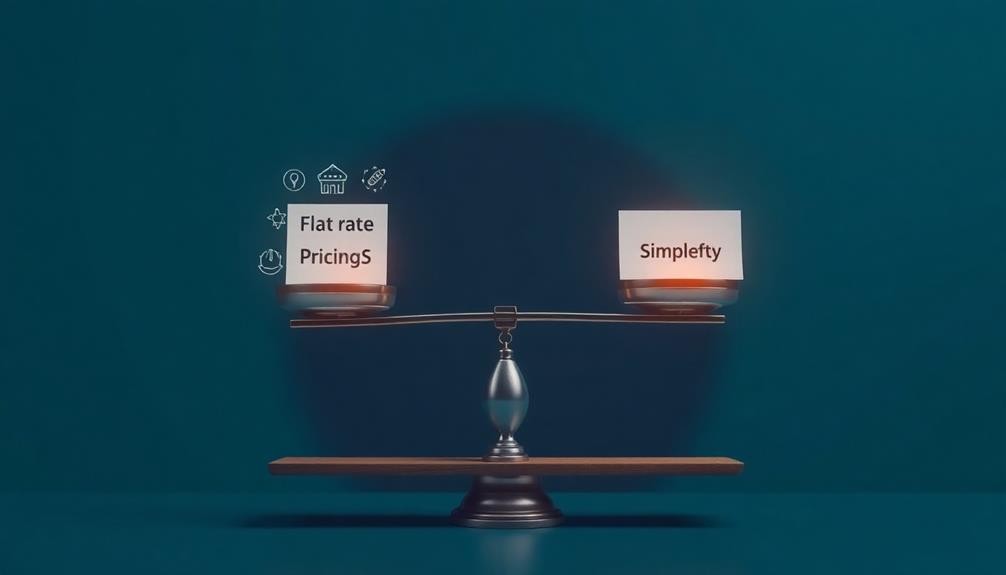
When you choose flat-rate pricing, you gain predictable expense management, making it easier to budget your processing costs.
The simplified fee structure means you won't have to worry about fluctuating rates or complicated calculations.
This pricing model can also enhance effective fraud prevention tools by allowing merchants to allocate funds toward security measures without unexpected fees.
Plus, the quick setup process lets you start accepting payments without a hassle, so you can focus on growing your business.
Predictable Expense Management
Predictable expense management is a game changer for businesses looking to streamline their finances. With flat-rate pricing, you pay a fixed fee per transaction, typically ranging from 2-3%. This stability allows you to predict your processing fees accurately, making it easier to budget without worrying about fluctuations from different transaction types.
By utilizing tools like email marketing databases, businesses can further enhance their financial forecasting and improve customer engagement.
For small businesses and startups, this simplicity is essential. You don't have to spend time deciphering complex pricing models or tracking multiple variables. Instead, you can focus on your core business operations and growth.
The predictability of flat-rate pricing also means you can easily reconcile your accounts, as there are fewer variables to manage compared to other structures.
Moreover, flat-rate pricing generally results in fewer hidden fees. This transparency helps you maintain clear visibility over your overall processing costs, reducing the likelihood of unexpected expenses.
Simplified Fee Structure
Flat-rate pricing simplifies your financial management by offering a consistent percentage fee per transaction, usually between 2-3%. This simplified fee structure means you won't have to worry about varying rates based on card types, making it easier to understand your processing costs.
With flat-rate pricing, you can enjoy predictable expenses, which is essential for effective financial planning, similar to how a retirement savings plan helps in achieving long-term financial goals. You'll know exactly what to expect each month, eliminating surprises that can disrupt your budget.
This model is particularly advantageous for small businesses and startups with low to moderate transaction volumes. Since there are no hidden charges lurking in the fine print, you can have a clearer understanding of your overall processing expenses.
This transparency allows you to allocate resources more effectively and plan for future growth without the stress of unexpected fees.
Additionally, the straightforward nature of flat-rate pricing means you can quickly set up accounts to start accepting credit card payments without needing extensive financial expertise.
This ease of use empowers you to focus on growing your business rather than getting bogged down in complex pricing structures. Overall, flat-rate pricing offers a valuable solution for managing your financial operations efficiently.
Quick Setup Process
Simplifying your payment processing setup can be a game-changer for your business. With flat-rate pricing, you'll enjoy a quick setup process that allows you to start accepting credit card payments almost immediately. This model is especially beneficial for small business owners who may not have extensive technical expertise.
Additionally, adopting a holistic SEO approach can enhance your overall business visibility while you manage your payment processes effectively. Here are some key advantages:
- Minimal paperwork: You'll face far less documentation compared to interchange-plus models.
- Instant understanding of processing costs: You pay a single percentage fee per transaction, making it easy to budget.
- Immediate access to funds: Say goodbye to waiting periods; your money is available right away.
- User-friendly platforms: Most flat-rate processors offer intuitive interfaces that simplify payment management.
These features contribute to predictable fees that can streamline financial planning and accounting. You won't have to worry about deciphering variable costs, allowing you to focus more on growing your business rather than getting bogged down in complexities.
Embracing flat-rate pricing means you can hit the ground running with confidence and clarity in your payment processing.
Disadvantages of Flat-Rate Pricing

Many businesses find flat-rate pricing appealing due to its straightforward nature, but it comes with considerable drawbacks. One major issue is that flat-rate pricing can lead to higher costs, especially for those with high transaction volumes. The fixed rate often exceeds what you'd pay under an interchange-plus model, particularly for lower interchange transactions.
Additionally, businesses in sectors like transportation and healthcare may struggle to find cost-effective solutions that meet their unique needs, as pricing models often lack flexibility and scalability, making it challenging to adapt as business operations evolve efficient payment solutions.
Moreover, this pricing model lacks transparency, making it difficult to understand the true cost of processing. You might miss out on potential cost savings that come from lower interchange rates available for specific card types, since all transactions are billed at the same rate, regardless of card classification.
Flat-rate pricing can also be inflexible, failing to accommodate your unique needs or industry-specific processing requirements. This rigidity can result in additional costs for your business.
While the simplicity of flat-rate pricing seems attractive, it may not be the most cost-effective solution as your business grows and transaction volumes increase. Ultimately, this could lead to overpayment in processing fees, which can considerably impact your bottom line.
Understanding Interchange-Plus Pricing
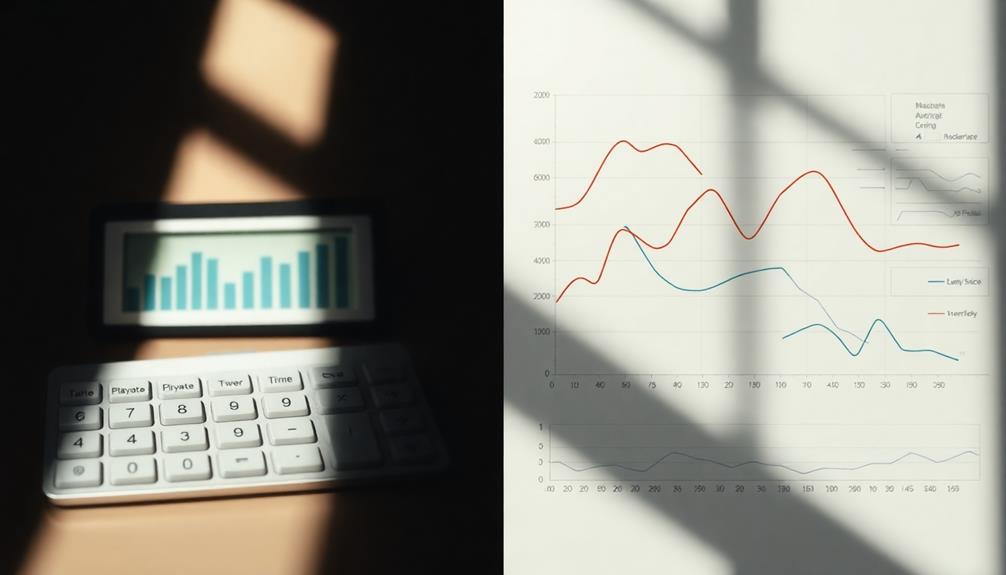
Interchange-plus pricing offers a transparent alternative to flat-rate pricing by breaking down transaction costs into two clear components: the actual interchange fees set by card networks and a fixed processor markup. This model brings several benefits that can help you manage your finances more effectively.
Additionally, similar to the way Bitcoin IRA offers tax-efficient growth for retirement savings, interchange-plus pricing can lead to potential savings for your business.
- Transparent Breakdown: You can see exactly how much you're paying in interchange fees and processor markup for each transaction.
- Lower Interchange Rates: This pricing structure often provides lower fees for card-present sales, making it more cost-effective for businesses with physical locations.
- Consistent Markup: The fixed markup remains the same regardless of card type, allowing you to predict your costs more accurately.
- Financial Tracking: You'll have the ability to track costs meticulously, enhancing your overall financial management.
However, be aware that while interchange-plus pricing can lead to savings, it does come with some complexity. Understanding the variable components of your transaction costs may require more effort compared to the simplicity of flat-rate pricing.
Ultimately, the clearer insights into transaction costs might outweigh the extra work involved.
Benefits of Interchange-Plus Pricing
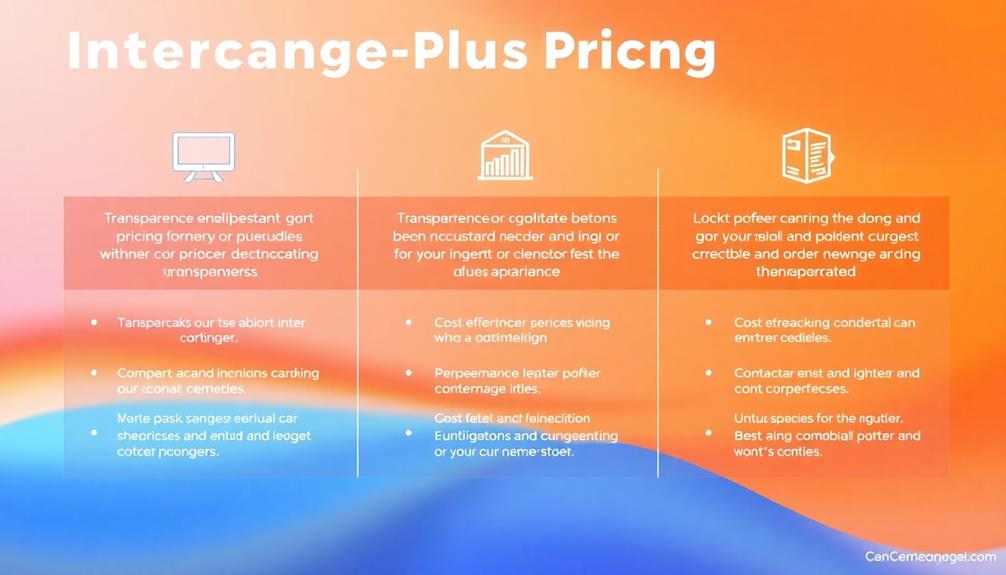
One of the key advantages of interchange-plus pricing is its transparency, allowing you to see exactly what you're paying for each transaction. This model provides a detailed breakdown of the actual interchange fees charged by card networks, letting you understand your processing costs better.
With interchange-plus pricing, you can often achieve lower overall costs, especially if your business has higher transaction volumes. The fixed markup remains consistent while you benefit from lower interchange rates on most transactions.
Most everyday transactions qualify for these lower interchange rates, making this pricing model particularly beneficial for businesses that process a high volume of sales. By switching from flat-rate pricing to interchange-plus pricing, you could potentially save thousands annually due to the variable nature of interchange fees. These significant savings allow you to allocate resources more effectively.
Additionally, the transparency of interchange-plus pricing empowers you to analyze your processing costs thoroughly, helping you refine your payment processing strategies. This informed decision-making capability can lead to even more savings over time, making interchange-plus pricing an attractive option for savvy business owners.
Drawbacks of Interchange-Plus Pricing
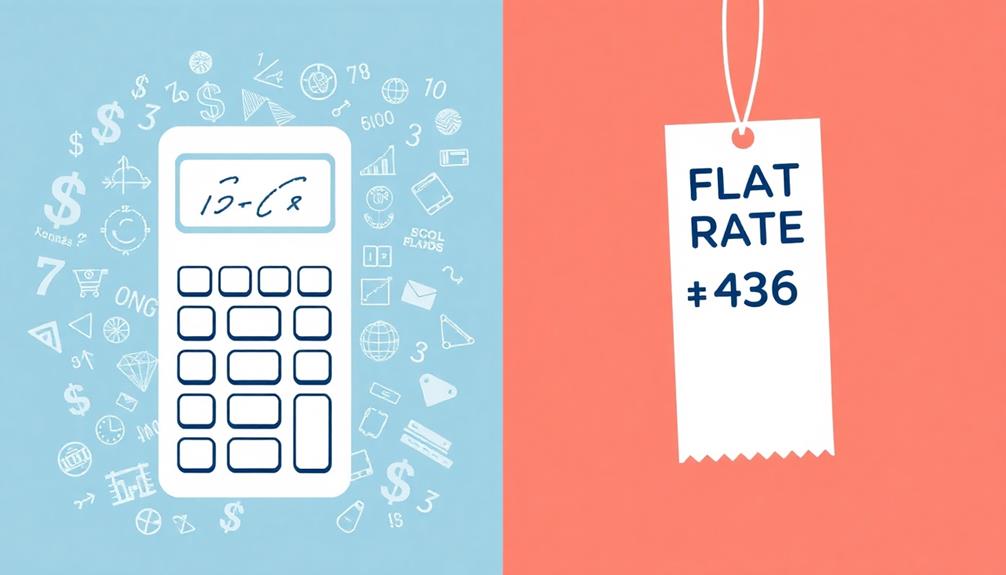
Frequently, businesses encounter challenges with interchange-plus pricing due to its inherent complexity. This pricing model can create several hurdles that may impact your bottom line, especially if you're running a small business.
Here are some key drawbacks:
- Variable Interchange Fees: These fees fluctuate based on the card type and transaction method, making it tough to predict your overall costs.
- Unpredictability: Month-to-month processing costs can vary considerably, depending on transaction volumes and customer payment preferences.
- Hidden Fees: There's a risk of unearthing hidden fees within the processor's markup, requiring you to scrutinize your processing statements closely.
- Financial Management: Steering through the intricacies of interchange-plus pricing demands advanced financial management skills, which might be overwhelming for smaller businesses with limited resources.
Due to these factors, budgeting becomes a challenge, leaving you at the mercy of fluctuating interchange rates and unpredictable processing costs.
This can create financial strain, making it essential to weigh these drawbacks carefully before opting for interchange-plus pricing.
Cost Comparison of Pricing Models
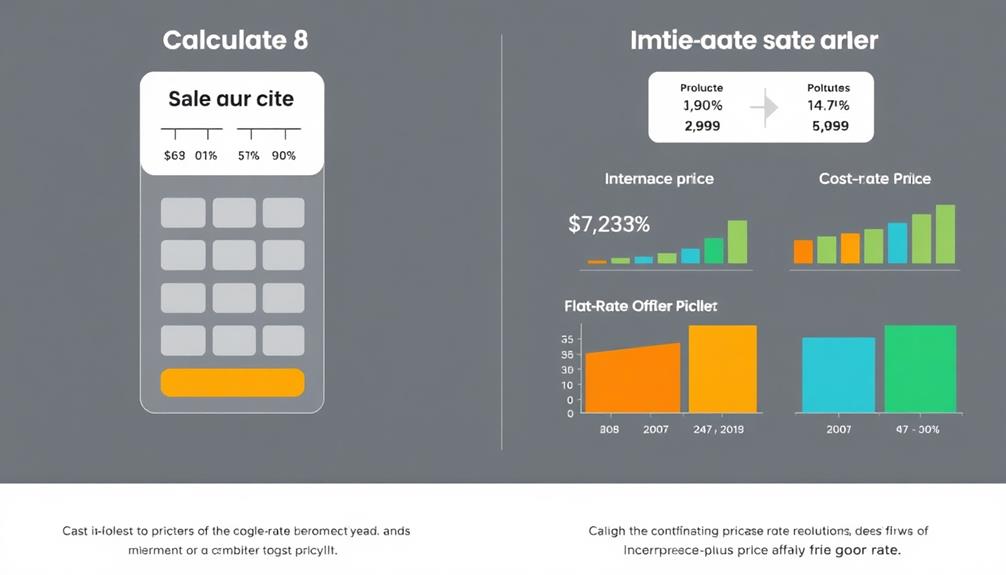
When comparing the cost of flat-rate and interchange-plus pricing models, you'll want to look closely at the fee structures.
Flat-rate fees are simple but can add up quickly, especially if your transaction volume is high.
On the other hand, interchange-plus pricing can offer significant savings, particularly for businesses with many lower-cost transactions.
Flat Rate Fees Breakdown
Understanding the cost implications of flat-rate fees is essential for businesses evaluating their payment processing options. While flat rate pricing offers simplicity, it can often lead to higher overall costs compared to interchange-plus pricing, especially for businesses with higher transaction volumes.
Here's a breakdown of how flat rate fees work:
- Standard Rates: Flat-rate pricing typically charges around 2.9% + $0.30 per transaction.
- Example Calculation: For a $50 transaction, your processing fee would be $1.75.
- Card Type Matters: Depending on the card type, interchange-plus pricing could result in lower fees, highlighting potential savings.
- Volume Impact: Businesses with high volumes of low interchange rate transactions may miss out on significant savings offered by interchange-plus pricing.
While the predictability of flat rate fees simplifies budgeting, it can mask higher costs, especially for larger businesses.
This pricing model often prevents you from benefiting from lower interchange rates, leading to potential overpayments. Understanding these nuances will help you determine if flat rate fees align with your business needs.
Interchange-Plus Savings Potential
Interchange-plus pricing can be a game-changer for businesses looking to optimize their payment processing costs. If you're processing over $50,000 annually, you could see significant savings compared to flat-rate pricing.
With a typical interchange-plus rate of 1.65% plus a $0.25 fee, you might save around $1,350 monthly on processing fees, especially for card-present transactions like debit cards.
The real advantage of interchange-plus pricing lies in its transparency. You get a clear view of the exact fees and margins, making it easier to track your overall costs.
In contrast, flat-rate pricing's fixed fee structure often results in higher expenses, as it doesn't account for the lower interchange rates that many businesses could take advantage of.
Transaction Volume Impact
For businesses processing a high volume of transactions, the choice between flat-rate and interchange-plus pricing can greatly impact overall costs.
With flat rate processing, you might be paying a consistent fee of around 2.9% + $0.30 per transaction, which can lead to higher fees and make your expenses escalate quickly.
On the other hand, interchange-plus pricing offers a more tailored approach that can yield significant cost savings.
Here are some key points to evaluate regarding transaction volume impact:
- Higher interchange fees: Flat-rate pricing doesn't account for varying interchange rates, which can hurt your bottom line.
- Cost efficiency: Interchange-plus pricing allows you to save on transactions that qualify for lower interchange rates.
- Annual fee comparison: A business processing $100,000 could pay about $3,100 with flat-rate versus potentially only $1,750 with interchange-plus.
- Volume benefits: As your transaction volume increases, the advantages of interchange-plus pricing become even more pronounced.
Ultimately, if you're processing a significant amount of transactions, opting for interchange-plus pricing could lead to substantial savings.
Factors in Choosing a Model
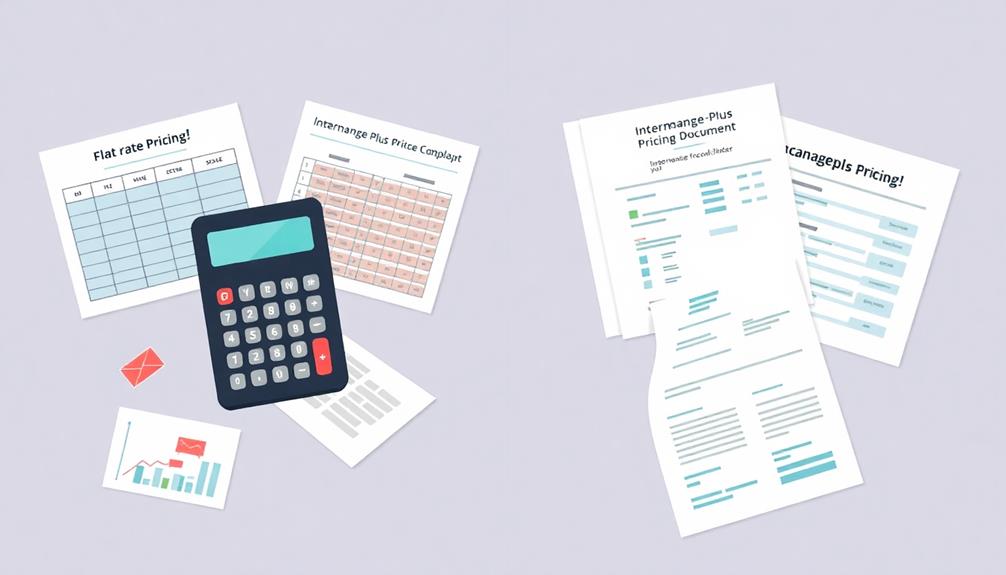
Choosing the right pricing model for your business is vital to managing costs effectively. When evaluating flat-rate pricing versus interchange-plus pricing, consider your average transaction values. Flat-rate models can become costly for larger transactions since they charge a fixed fee, regardless of interchange rates.
On the other hand, if you have a high transaction volume with numerous low-interchange transactions, interchange-plus pricing might be more beneficial, potentially leading to lower overall fees.
Predictability of costs is another key factor. Flat-rate pricing provides a consistent fee structure, simplifying budgeting for smaller businesses. In contrast, interchange-plus pricing can vary based on card types and transaction specifics, which might complicate financial planning.
Additionally, assess your chargeback frequency. A high chargeback rate can inflate fees within interchange-plus pricing models, making them less favorable.
Finally, understanding your specific business needs, including growth potential and industry type, is essential. For instance, flat-rate pricing might suit startups, while established businesses with larger transaction volumes could find interchange-plus pricing more advantageous.
Final Thoughts on Pricing Options

As you weigh your options for payment processing, it's essential to recognize the strengths and weaknesses of each pricing model. Both flat-rate and interchange-plus pricing have distinct features that cater to different business needs. Here's a quick breakdown to help you decide:
- Flat Rate: Simplifies budgeting with a fixed fee per transaction, ideal for small businesses with lower transaction volumes.
- Interchange-Plus Pricing: Offers transparency by breaking down costs into interchange fees and processor markup, appealing for those with higher transaction volumes.
- Transaction Types: Consider your specific transaction types; high-ticket transactions often incur higher costs under flat-rate pricing.
- Predictability vs. Savings: Flat-rate pricing provides predictability, while interchange-plus can lead to savings if you process a lot of low interchange rate transactions.
Ultimately, as a business owner, you'll need to assess your transaction types and volumes carefully. Each pricing structure has its pros and cons, and understanding these nuances will empower you to make a more informed decision that aligns with your financial goals.
Choose wisely, and keep an eye on those costs!
Frequently Asked Questions
Is Interchange Plus Better Than Flat Rate?
When you consider interchange-plus pricing, you might find it better suited for your business, especially if you process many transactions. It can reduce costs and provide clearer insights into your processing fees, enhancing your financial management.
Why Is Flat Rate Pricing Better?
Did you know 70% of small businesses prefer flat rate pricing? It simplifies budgeting and eliminates hidden fees, letting you focus on growth. You'll appreciate the straightforward structure, making financial management less stressful and more efficient.
What Is Interchange Plus Plus Pricing?
Interchange Plus Pricing breaks down transaction costs into separate interchange fees and processor markups. You'll gain transparency and potentially save money, especially if you process many low-interchange transactions, allowing for better cost predictability.
Who Benefits From Interchange Fees?
Think of interchange fees as a river, flowing benefits to various banks and merchants. You, as a merchant, gain advantages when processing transactions, especially with debit cards, which can lower your overall costs considerably.
Conclusion
When it comes to choosing between flat-rate and interchange-plus pricing, the right choice hinges on your business's unique needs. While flat-rate offers simplicity and predictability, interchange-plus can lead to cost savings for higher volumes. But here's the kicker: many businesses overlook hidden fees that can skew their decision. So, take a closer look at your transaction patterns and don't just settle for the surface; dig deeper to uncover the true costs behind each pricing model.

